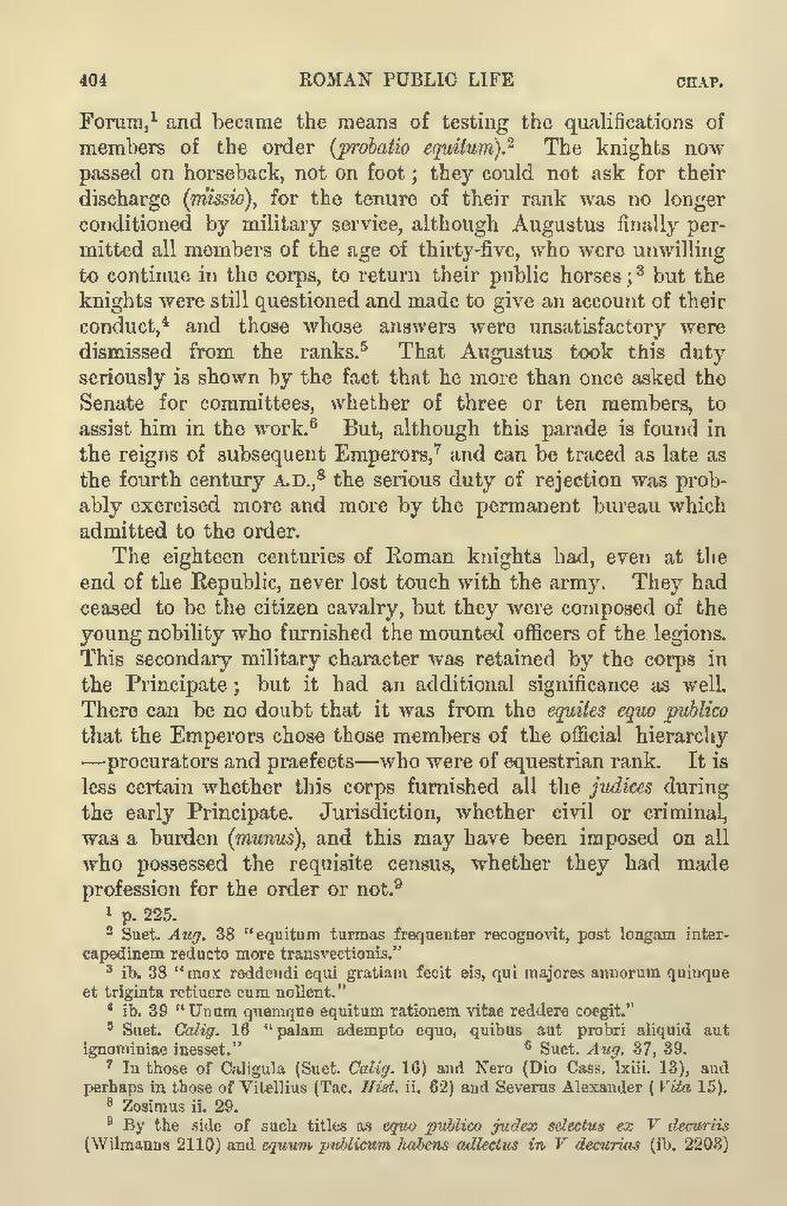Forum,[1] and became the means of testing the qualifications of members of the order (probatio equitum).[2] The knights now passed on horseback, not on foot; they could not ask for their discharge (missio), for the tenure of their rank was no longer conditioned by military service, although Augustus finally permitted all members of the age of thirty-five, who were unwilling to continue in the corps, to return their public horses;[3] but the knights were still questioned and made to give an account of their conduct,[4] and those whose answers were unsatisfactory were dismissed from the ranks.[5] That Augustus took this duty seriously is shown by the fact that he more than once asked the Senate for committees, whether of three or ten members, to assist him in the work.[6] But, although this parade is found in the reigns of subsequent Emperors,[7] and can be traced as late as the fourth century A.D.,[8] the serious duty of rejection was probably exercised more and more by the permanent bureau which admitted to the order.
The eighteen centuries of Roman knights had, even at the end of the Republic, never lost touch with the army. They had ceased to be the citizen cavalry, but they were composed of the young nobility who furnished the mounted officers of the legions. This secondary military character was retained by the corps in the Principate; but it had an additional significance as well. There can be no doubt that it was from the equites equo publico that the Emperors chose those members of the official hierarchy—procurators and praefects—who were of equestrian rank. It is less certain whether this corps furnished all the judices during the early Principate. Jurisdiction, whether civil or criminal, was a burden (munus), and this may have been imposed on all who possessed the requisite census, whether they had made profession for the order or not.[9]*
- ↑ p. 225.
- ↑ Suet. Aug. 38 "equitum turmas frequenter recognovit, post longam intercapedinem reducto more transvectionis."
- ↑ ib. 38 "mox reddendi equi gratiam fecit eis, qui majores annorum quinque et triginta retinere eum nollent."
- ↑ ib. 39 "Unum quemque equitum rationem vitae reddere coegit."
- ↑ Suet. Calig. 16 "palam adempto equo, quibus aut probri aliquid aut ignominiae inesset."
- ↑ Suet. Aug. 37, 39.
- ↑ In those of Caligula (Suet. Calig. 16) and Nero (Dio Cass. lxiii. 13), and perhaps in those of Vitellius (Tac. Hist. ii. 62) and Severus Alexander (Vita 15).
- ↑ Zosimus ii. 29.
- ↑ By the side of such titles as equo publico judex selectus ex V decuriis (Wilmanns 2110) and equum publicum habens adlectus in V decurias (ib. 2203)
